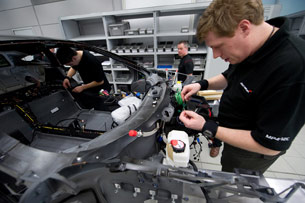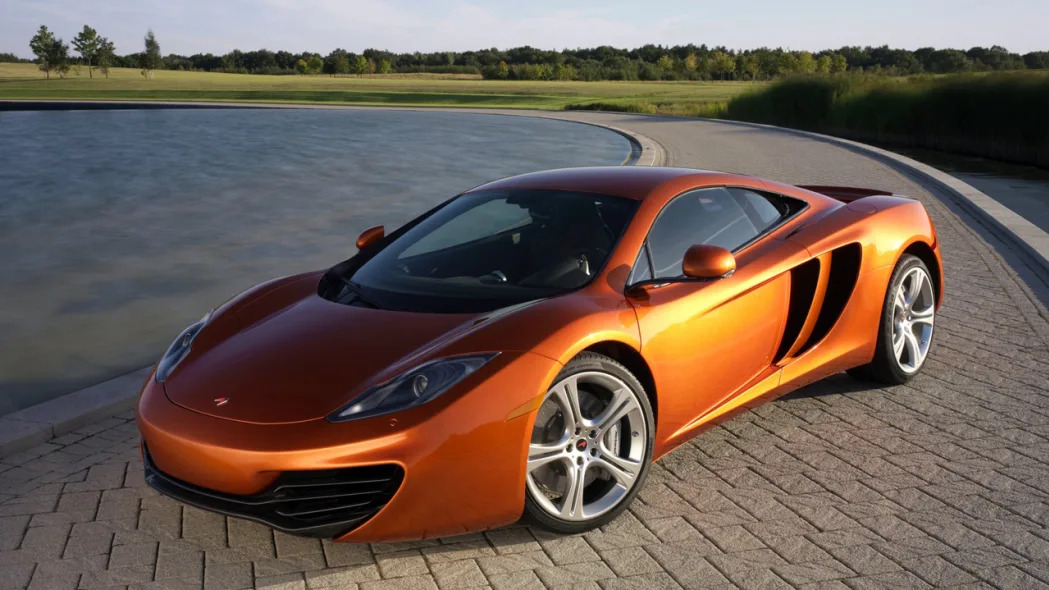McLaren MP4-12C – Click above for high-res image gallery
At a press conference held at its technology center in the UK this morning, McLaren Automotive officially launched itself into existence as a real, honest-to-goodness automaker. McLaren Automotive chairman Ron Dennis introduced the new MP4-12C by reminding the audience that since McLaren entered Formula One competition in 1966, the team has won 25 percent of all the races that have taken place. McLaren created the first carbon fiber chassis F1 car in 1981 and the first series production road car with a carbon chassis. The now-departed Mercedes-McLaren SLR was the highest-selling carbon fiber chassis road car ever (so far).
The MP4-12C is the next chapter in the story. Dennis emphasized that the MP4-12C and future McLaren products will be engineered, manufactured and most importantly exported from the UK. Dennis repeatedly used the word passion when discussing what McLaren wanted to achieve. Anthony Sheriff, Managing Director of McLaren Automotive discussed the car in more detail. When the program started five years ago, McLaren decided that it needed to be better than its competitors in Italy and Germany. If a customer wanted a car as good as a Ferrari, Lamborghini or Porsche, they could just buy one of those cars.
Continue reading after the jump and stay tuned for live images of the MP4-12C from McLaren's press conference.
[Source: McLaren]
According to Sherriff the over-riding factors in the design of the MP4-12C were obtaining maximum performance through efficiency. Efficiency includes an emphasis on light weight and aerodynamic efficiency. The carbon fiber mono-cell tub is at the heart of this, Following in the tradition of 30 years of McLaren race and road cars, the central structure is designed to be strong, stiff and light. McLaren has also developed new methods of producing this tub.
Manufacturing carbon fiber parts typically has a cycle time of 24 hours or more. The machine that produces McLaren's mono-cell can turn out parts in just four hours. The carbon mat is put into the mold, the resin is injected and after two hours of curing time, the tub comes out. After trimming it is ready for assembly. Sherriff explained that the corner-to-corner dimensional tolerance is less than 0.5 millimeters, which helps to ensure that the chassis of every single car complies with the design intent.

The entire structure is one single piece that has sacrificial aluminum structures attached to the front and rear. In a crash, the aluminum is designed to absorb the energy of the impact while the carbon tub remains intact to protect the occupants. Sherriff showed photos of the chassis being crash tested at 40 mph and a single tub was used for separate crash tests. Only the aluminum and some of the suspension components had to be replaced. The carbon remained free of cracks or other damage.
Continuing the low mass theme, Sherriff described the aluminum cross-car beam in the cockpit. The vendor that produces the beam wanted to have a raised embossed McLaren logo in the aluminum. The engineers took a look and decided that this would add needless mass and instead opted to have the logo engraved, which would take away material. It would only save 2.6 gram, but every little bit helps.
Similarly, the engineers saved a full four kilograms in the wiring harness by using hexagonal aluminum conductors rather than the traditional circular wires. That's the kind of attention to detail that gets you a 1,300-kilogram (about 2,870 pounds) car. Compare that to the 4,162-pound mass of a Bugatti Veyron, which is more the kitchen sink approach to building supercars. It's not as light as the 1,000-kg McLaren F1 with which it will inevitably be compared, but it features a lot more equipment than the older car including a full complement of airbags.
%Video-1106%
On the powertrain front, efficiency also comes into play. Unlike the F1 and SLR that feature engines built by BMW and Mercedes-Benz, the 12C features a new bespoke powerplant produced by McLaren. The M838T is a twin-turbocharged and direct-injected V8 that produces 600 horsepower and 443 pound-feet of torque. Particularly impressive is the fact that at least 369 lb-ft of that torque is available everywhere from 2,000 rpm to the lofty 8,000 rpm red-line, which should make this engine particularly tractable.
Power is sent to the rear wheels through a dual clutch gearbox that features what McLaren calls Pre-Cog (or pre-cognition for those who saw Minority Report). Like the shutter release on a camera that allows the user to lock in focus and exposure by pressing the release halfway, the pedals can be pulled back lightly to pre-condition the gearbox. Pressing the paddle all the way then allows almost instantaneous shifts.
The gearbox itself and the engine are particularly compact, which also aids the aerodynamic efficiency of the 12C. With the small powertrain and the exhaust that exits high through the rear panel of the car, McLaren was able to produce a rear diffuser that starts well forward under the tail of the car making it more effective. This combines with the air-brake on the top to produce more rear downforce, which allows the rear brakes to be much more effective in high speed driving.
Another example of the aerodynamic efficiency is the side-mounted radiators that are inline with the car. With the compact engine, this allows the car to be narrower, greatly reducing the frontal area and overall drag. The vents on the side duct direct air over the heat exchangers and then out the back.
One of the goals in the development of the 12C was to also create a livable supercar. That means it needed phenomenal performance but a comfortable ride for everyday driving. The "pro-active chassis control" gives the driver the option of three different modes for both the stability control and damping systems. The 12C also features a brake steer system similar to what is used on the F1 cars. That is, the individual rear brakes can be applied to help the car turn in on tight corners.
To aid ride comfort, McLaren has what is essentially an infinitely variable roll control system. Instead of using huge anti-roll bars that invariably limit side-to-side wheel motion, the 12C has no roll bars. Hydraulic actuators at each corner allow full range of wheel motion in a straight line and then tighten up as the cornering forces build.

The 12C should be equally livable on the inside. McLaren has developed what it calls its IRIS infotainment system. A portrait mode seven-inch touch screen in the center is backed up by a 1.6 GHz Intel processor and Microsoft software. It features a full the complement of physical and wireless (including Bluetooth and WIFI) ports for connecting phones and other devices. Of course, all that stuff should be left behind if you are going to seriously exercise this car.
Unlike many small wannabe supercar builders, McLaren has the resources to properly develop and build a real supercar. By the end of this year, McLaren will have accumulated over one million test miles on prototypes along with completing over 100 crash tests. The new standalone automaker also intends to provide an exemplary level of customer service through its new global dealer network and offer customers plenty of room to personalize their cars.
In order to build the top-notch, high quality car that people expect, McLaren has also put a lot of effort into its production process. The U-shaped assembly line is completely open and set up for lean manufacturing and just-in-time parts delivery. Everything will be inspected at every station and corrected there rather than waiting for end-of-line rework. Avoiding more extensive rework at the end of the line helps avoid other problems that can occur when everything is disassembled and re-assembled.




McLaren already employs 1,500 people at its facilities in the UK for both the car business and its F1 race team. Up to 300 additional jobs will be added to build the 12C and other models. McLaren's plan is to be building up to 4,000 cars a year by mid-decade. If it were anyone but Ron Dennis and McLaren trying to launch a new sports car company right now, most people would think the idea was ridiculous. While the previous F1 supercar was not a commercial success, McLaren as a whole has been remarkably successful over the last several decades. No one should count out this crew, especially since Ron Dennis is now focused on McLaren Automotive and no longer involved with the race team.
Over 500 dealers have applied to sell McLaren's cars, although the company will only launch with 35 outlets in 19 countries in 2011. McLaren intends to deliver over 1,000 cars in 2011 alone and then grow that number as more models are added to the lineup. Two other cars are already in development. The dealers, pricing and final performance numbers for the MP4-12C will all be announced in the second half of this year. To say we can't wait to drive it would be a huge understatement.







Sign in to post
Please sign in to leave a comment.
Continue